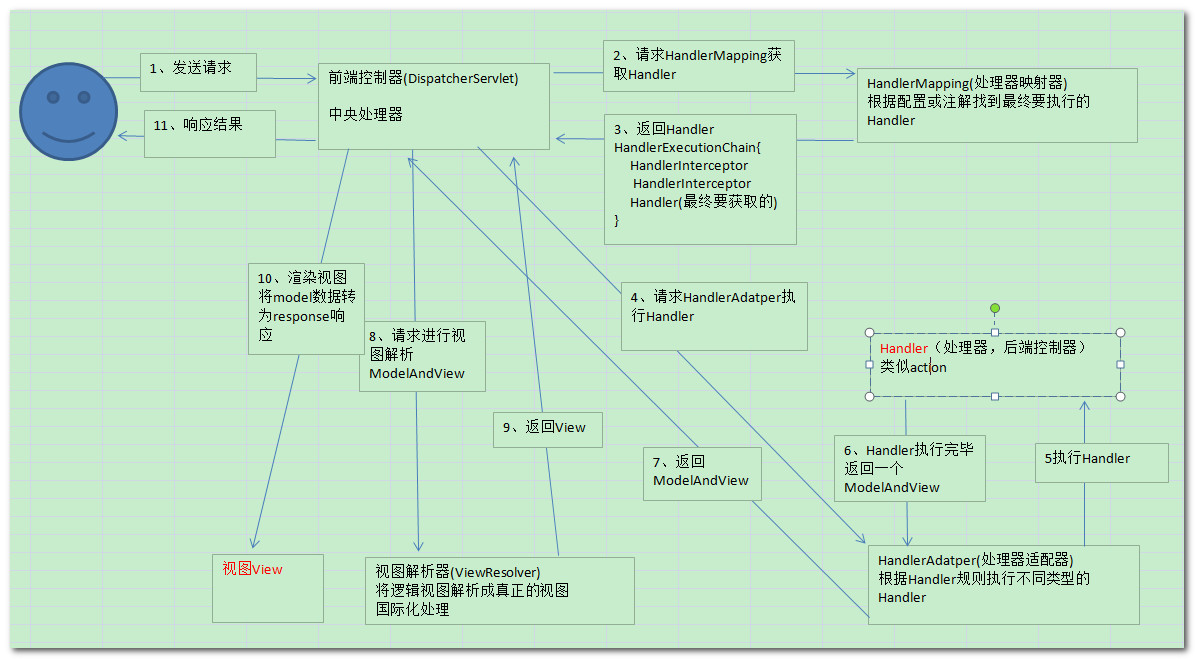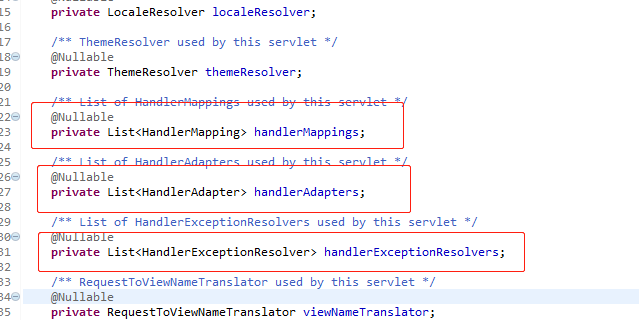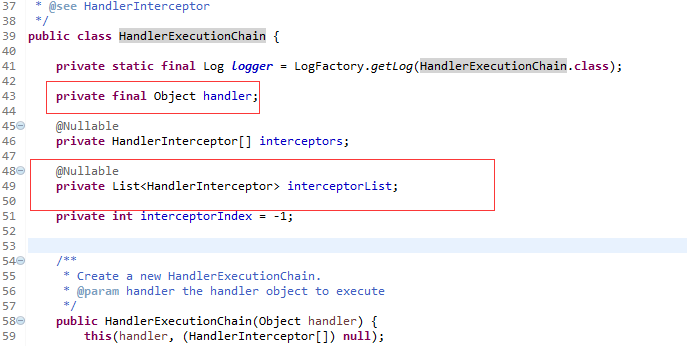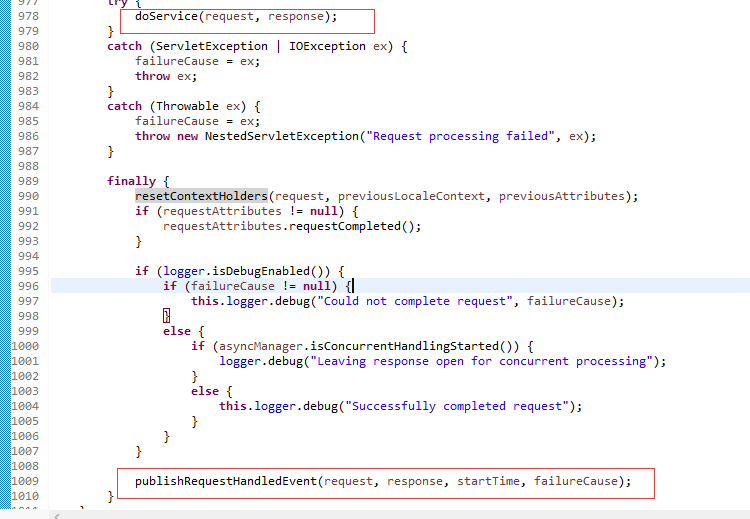SpringMVC之处理流程
之前在学servlet时写过JavaWeb与Asp.net工作原理比较分析,那篇主要是大致描述了下servlet的工作流程,今天在家了解了下springmvc的工作原理,与asp.net中的mvc进行了一下比较asp.net MVC 的处理流程,思想都是差不多,都是通过一个url怎么映射到类中做完处理返回浏览器的过程,首先要解决三大问题,一是url映射转换成request和response对象的问题二是浏览器与服务端的数据交互问题三是服务端的request、response怎么响应给客户端。今天了解了下它的运行流畅,其实网上也有好多教程。
一图顶千言万语,用数据、用图说话,下图是springmvc的工作原理图。 
SpringMVC工作流程
一、 用户发送请求至前端控制器DispatcherServlet。
1.DispatcherServlet它也是servlet,load-on-startup=1,tomcat启动时它也会初始化,初始化参数是contextConfigLocation上下文配置文件位置,参数值就是JavaWeb之Eclipse中使用Maven构建SpringMVC项目 配置的spring-mvc。在spring-mvc中可以配置自动扫描包名、默认注解映射支持、视图解释类、拦截器、对静态资源文件的访问等信息,通过自动扫描包名、注解映射支持、静态资源访问这些配置的信息在就会实例化HandlerMapping对象。这些对象是在tomcat进行参数初始化的时候也会实例化完成。在DispatcherServlet中维护着一个表,类似C#MVC中的RouteTable 路由表,存放的是HandlerMapping对象list.下面截图是DispatcherServlet中的部分代码,在DispatcherServlet中维护着handerMappings、handerAdapters等对象列表。在initStrategies中对上面的一些属性进行初始化。


protected void initStrategies(ApplicationContext context) { initMultipartResolver(context); initLocaleResolver(context); initThemeResolver(context); initHandlerMappings(context); initHandlerAdapters(context); initHandlerExceptionResolvers(context); initRequestToViewNameTranslator(context); initViewResolvers(context); initFlashMapManager(context); }
2.客户端发出请求,由 Tomcat 接收到这个请求,如果匹配 DispatcherServlet 在 web.xml 中配置的映射路径,Tomcat 就将请求转交给 DispatcherServlet 处理
二、 DispatcherServlet收到请求调用HandlerMapping处理器映射器。
请求到达DispatcherServlet中之后,就是get、post这些请求,这些请求是DispatcherServlet的父类FrameworkServlet中定义着的,而在这些方法中又调用了processRequest,processRequest中调用了doService,DispatcherServlet重写了doService方法,doService中主要设置了一些属性和调用doDispatch方法,doDispatch用来做分发请求。

protected void doDispatch(HttpServletRequest request, HttpServletResponse response) throws Exception { HttpServletRequest processedRequest = request; HandlerExecutionChain mappedHandler = null; boolean multipartRequestParsed = false; WebAsyncManager asyncManager = WebAsyncUtils.getAsyncManager(request); try { ModelAndView mv = null; Exception dispatchException = null; try { processedRequest = checkMultipart(request); multipartRequestParsed = (processedRequest != request); // Determine handler for the current request. mappedHandler = getHandler(processedRequest); if (mappedHandler == null) { noHandlerFound(processedRequest, response); return; } // Determine handler adapter for the current request. HandlerAdapter ha = getHandlerAdapter(mappedHandler.getHandler()); // Process last-modified header, if supported by the handler. String method = request.getMethod(); boolean isGet = "GET".equals(method); if (isGet || "HEAD".equals(method)) { long lastModified = ha.getLastModified(request, mappedHandler.getHandler()); if (logger.isDebugEnabled()) { logger.debug("Last-Modified value for [" + getRequestUri(request) + "] is: " + lastModified); } if (new ServletWebRequest(request, response).checkNotModified(lastModified) && isGet) { return; } } if (!mappedHandler.applyPreHandle(processedRequest, response)) { return; } // Actually invoke the handler. mv = ha.handle(processedRequest, response, mappedHandler.getHandler()); if (asyncManager.isConcurrentHandlingStarted()) { return; } applyDefaultViewName(processedRequest, mv); mappedHandler.applyPostHandle(processedRequest, response, mv); } catch (Exception ex) { dispatchException = ex; } catch (Throwable err) { // As of 4.3, we're processing Errors thrown from handler methods as well, // making them available for @ExceptionHandler methods and other scenarios. dispatchException = new NestedServletException("Handler dispatch failed", err); } processDispatchResult(processedRequest, response, mappedHandler, mv, dispatchException); } catch (Exception ex) { triggerAfterCompletion(processedRequest, response, mappedHandler, ex); } catch (Throwable err) { triggerAfterCompletion(processedRequest, response, mappedHandler, new NestedServletException("Handler processing failed", err)); } finally { if (asyncManager.isConcurrentHandlingStarted()) { // Instead of postHandle and afterCompletion if (mappedHandler != null) { mappedHandler.applyAfterConcurrentHandlingStarted(processedRequest, response); } } else { // Clean up any resources used by a multipart request. if (multipartRequestParsed) { cleanupMultipart(processedRequest); } } } }
上面的代码是核心代码,其实下面的几项其实就是代码的说明.
processedRequest = checkMultipart(request);
multipartRequestParsed = (processedRequest != request);
上面这两句是判断请求是不是上传文件的请求
三、 处理器映射器找到具体的处理器(可以根据xml配置、注解进行查找),生成处理器对象及处理器拦截器(如果有则生成)一并返回给DispatcherServlet。
mappedHandler = getHandler(processedRequest); if (mappedHandler == null) { noHandlerFound(processedRequest, response); return; }


getHander返回的是一个HandlerExecutionChain,这个HandlerExecutionChain中包含一个handler和多个HandlerInterceptor(拦截器),这个和asp.net中的管道模型有点类似,一个httphandler和多个httpmodule,httpmodule也是用来做拦截操作的。同时要留意HandlerExecutionChain是通过HandlerMapping对象的getHandler获取的.其实这里还可以扩展比如拦截器的使用、HandlerMapping的介绍等,由于篇幅有限,会在以后的博客中一个一个的介绍。
四、 DispatcherServlet调用HandlerAdapter处理器适配器。
HandlerAdapter ha = getHandlerAdapter(mappedHandler.getHandler());

protected HandlerAdapter getHandlerAdapter(Object handler) throws ServletException { if (this.handlerAdapters != null) { for (HandlerAdapter ha : this.handlerAdapters) { if (logger.isTraceEnabled()) { logger.trace("Testing handler adapter [" + ha + "]"); } if (ha.supports(handler)) { return ha; } } } throw new ServletException("No adapter for handler [" + handler + "]: The DispatcherServlet configuration needs to include a HandlerAdapter that supports this handler"); }
获取适配器是通过遍历handlerAdapters列表找的,HandlerAdapter包含了3个方法.boolean supports(Object handler);ModelAndView handle(HttpServletRequest request, HttpServletResponse response, Object handler) throws Exception;long getLastModified(HttpServletRequest request, Object handler);

/* * Copyright 2002-2013 the original author or authors. * * Licensed under the Apache License, Version 2.0 (the "License"); * you may not use this file except in compliance with the License. * You may obtain a copy of the License at * * http://www.apache.org/licenses/LICENSE-2.0 * * Unless required by applicable law or agreed to in writing, software * distributed under the License is distributed on an "AS IS" BASIS, * WITHOUT WARRANTIES OR CONDITIONS OF ANY KIND, either express or implied. * See the License for the specific language governing permissions and * limitations under the License. */ package org.springframework.web.servlet; import javax.servlet.http.HttpServletRequest; import javax.servlet.http.HttpServletResponse; import org.springframework.lang.Nullable; /** * MVC framework SPI, allowing parameterization of the core MVC workflow. * * <p>Interface that must be implemented for each handler type to handle a request. * This interface is used to allow the {@link DispatcherServlet} to be indefinitely * extensible. The {@code DispatcherServlet} accesses all installed handlers through * this interface, meaning that it does not contain code specific to any handler type. * * <p>Note that a handler can be of type {@code Object}. This is to enable * handlers from other frameworks to be integrated with this framework without * custom coding, as well as to allow for annotation-driven handler objects that * do not obey any specific Java interface. * * <p>This interface is not intended for application developers. It is available * to handlers who want to develop their own web workflow. * * <p>Note: {@code HandlerAdapter} implementors may implement the {@link * org.springframework.core.Ordered} interface to be able to specify a sorting * order (and thus a priority) for getting applied by the {@code DispatcherServlet}. * Non-Ordered instances get treated as lowest priority. * * @author Rod Johnson * @author Juergen Hoeller * @see org.springframework.web.servlet.mvc.SimpleControllerHandlerAdapter * @see org.springframework.web.servlet.handler.SimpleServletHandlerAdapter */ public interface HandlerAdapter { /** * Given a handler instance, return whether or not this {@code HandlerAdapter} * can support it. Typical HandlerAdapters will base the decision on the handler * type. HandlerAdapters will usually only support one handler type each. * <p>A typical implementation: * <p>{@code * return (handler instanceof MyHandler); * } * @param handler handler object to check * @return whether or not this object can use the given handler */ boolean supports(Object handler); /** * Use the given handler to handle this request. * The workflow that is required may vary widely. * @param request current HTTP request * @param response current HTTP response * @param handler handler to use. This object must have previously been passed * to the {@code supports} method of this interface, which must have * returned {@code true}. * @throws Exception in case of errors * @return ModelAndView object with the name of the view and the required * model data, or {@code null} if the request has been handled directly */ @Nullable ModelAndView handle(HttpServletRequest request, HttpServletResponse response, Object handler) throws Exception; /** * Same contract as for HttpServlet's {@code getLastModified} method. * Can simply return -1 if there's no support in the handler class. * @param request current HTTP request * @param handler handler to use * @return the lastModified value for the given handler * @see javax.servlet.http.HttpServlet#getLastModified * @see org.springframework.web.servlet.mvc.LastModified#getLastModified */ long getLastModified(HttpServletRequest request, Object handler); }
五、 HandlerAdapter经过适配调用具体的处理器(Controller,也叫后端控制器)。
六、 Controller执行完成返回ModelAndView。
七、 HandlerAdapter将controller执行结果ModelAndView返回给DispatcherServlet。

// Process last-modified header, if supported by the handler. String method = request.getMethod(); boolean isGet = "GET".equals(method); if (isGet || "HEAD".equals(method)) { long lastModified = ha.getLastModified(request, mappedHandler.getHandler()); if (logger.isDebugEnabled()) { logger.debug("Last-Modified value for [" + getRequestUri(request) + "] is: " + lastModified); } if (new ServletWebRequest(request, response).checkNotModified(lastModified) && isGet) { return; } } if (!mappedHandler.applyPreHandle(processedRequest, response)) { return; } // Actually invoke the handler. mv = ha.handle(processedRequest, response, mappedHandler.getHandler());
上面的几行代码先判断如果是get请求更新下lastModified请求头,然后执行HandlerExecutionChain中的applyPreHandle这个方法.

boolean applyPreHandle(HttpServletRequest request, HttpServletResponse response) throws Exception { HandlerInterceptor[] interceptors = getInterceptors(); if (!ObjectUtils.isEmpty(interceptors)) { for (int i = 0; i < interceptors.length; i++) { HandlerInterceptor interceptor = interceptors[i]; if (!interceptor.preHandle(request, response, this.handler)) { triggerAfterCompletion(request, response, null); return false; } this.interceptorIndex = i; } } return true; }

void triggerAfterCompletion(HttpServletRequest request, HttpServletResponse response, @Nullable Exception ex) throws Exception { HandlerInterceptor[] interceptors = getInterceptors(); if (!ObjectUtils.isEmpty(interceptors)) { for (int i = this.interceptorIndex; i >= 0; i--) { HandlerInterceptor interceptor = interceptors[i]; try { interceptor.afterCompletion(request, response, this.handler, ex); } catch (Throwable ex2) { logger.error("HandlerInterceptor.afterCompletion threw exception", ex2); } } } }
在applyPreHandle中它会遍历该HandlerExecutionChain中所有的拦截器,然后使用拦截器通过preHandle对handler进行预处理,如果所有的拦截器都能处理那就会继续往下执行,如果一旦有一个拦截器不能处理,就没必要往下走了,那就会触发triggerAfterCompletion方法,在triggerAfterCompletion中它是倒序遍历的拦截器的,执行完triggerAfterCompletion返回false之后doDispatch这个方法就执行结束了,下面的八、九、十、十一就不再执行。从第五步括号里的备注也能猜出来HandlerExecutionChain.handler是什么,它可以是Controller。
八、 DispatcherServlet将ModelAndView传给ViewReslover视图解析器。
九、 ViewReslover解析后返回具体View。
applyDefaultViewName(processedRequest, mv);

private void applyDefaultViewName(HttpServletRequest request, @Nullable ModelAndView mv) throws Exception { if (mv != null && !mv.hasView()) { String defaultViewName = getDefaultViewName(request); if (defaultViewName != null) { mv.setViewName(defaultViewName); } } }

protected String getDefaultViewName(HttpServletRequest request) throws Exception { return (this.viewNameTranslator != null ? this.viewNameTranslator.getViewName(request) : null); }
找到ModelAndView对应的viewname,设置成它的属性值。
mappedHandler.applyPostHandle(processedRequest, response, mv);
applyPostHandle与applyPreHandle是对应着的,遍历handler的拦截器,执行postHandle方法。
十、DispatcherServlet根据View进行渲染视图(即将模型数据填充至视图中)。
processDispatchResult(processedRequest, response, mappedHandler, mv, dispatchException);

private void processDispatchResult(HttpServletRequest request, HttpServletResponse response, @Nullable HandlerExecutionChain mappedHandler, @Nullable ModelAndView mv, @Nullable Exception exception) throws Exception { boolean errorView = false; if (exception != null) { if (exception instanceof ModelAndViewDefiningException) { logger.debug("ModelAndViewDefiningException encountered", exception); mv = ((ModelAndViewDefiningException) exception).getModelAndView(); } else { Object handler = (mappedHandler != null ? mappedHandler.getHandler() : null); mv = processHandlerException(request, response, handler, exception); errorView = (mv != null); } } // Did the handler return a view to render? if (mv != null && !mv.wasCleared()) { render(mv, request, response); if (errorView) { WebUtils.clearErrorRequestAttributes(request); } } else { if (logger.isDebugEnabled()) { logger.debug("Null ModelAndView returned to DispatcherServlet with name '" + getServletName() + "': assuming HandlerAdapter completed request handling"); } } if (WebAsyncUtils.getAsyncManager(request).isConcurrentHandlingStarted()) { // Concurrent handling started during a forward return; } if (mappedHandler != null) { mappedHandler.triggerAfterCompletion(request, response, null); } }

protected void render(ModelAndView mv, HttpServletRequest request, HttpServletResponse response) throws Exception { // Determine locale for request and apply it to the response. Locale locale = (this.localeResolver != null ? this.localeResolver.resolveLocale(request) : request.getLocale()); response.setLocale(locale); View view; String viewName = mv.getViewName(); if (viewName != null) { // We need to resolve the view name. view = resolveViewName(viewName, mv.getModelInternal(), locale, request); if (view == null) { throw new ServletException("Could not resolve view with name '" + mv.getViewName() + "' in servlet with name '" + getServletName() + "'"); } } else { // No need to lookup: the ModelAndView object contains the actual View object. view = mv.getView(); if (view == null) { throw new ServletException("ModelAndView [" + mv + "] neither contains a view name nor a " + "View object in servlet with name '" + getServletName() + "'"); } } // Delegate to the View object for rendering. if (logger.isDebugEnabled()) { logger.debug("Rendering view [" + view + "] in DispatcherServlet with name '" + getServletName() + "'"); } try { if (mv.getStatus() != null) { response.setStatus(mv.getStatus().value()); } view.render(mv.getModelInternal(), request, response); } catch (Exception ex) { if (logger.isDebugEnabled()) { logger.debug("Error rendering view [" + view + "] in DispatcherServlet with name '" + getServletName() + "'", ex); } throw ex; } }
在processDispatchResult方法中有一句render(mv, request, response),在render中先是获取View对象然后调用view.render(mv.getModelInternal(), request, response);将view和model绑定来进行渲染试图。
十一、 DispatcherServlet响应用户。
响应用户其实是在父类FrameworkServlet的processRequest方法中

十二、小结
上面黑字部分是参考其他博客的,红色的是通过读源码找的,现在基本清楚springmvc大致的流程,其实如果继续深入的话,还有好多知识点,这篇博客就写到这,以后再慢慢补充。好久没熬夜学习了,今天算是毕业之后最用功的一天了,哈哈...(今天四月一,愚人节!!!)
参考:https://www.cnblogs.com/xiaoxi/p/6164383.html
作者:社会主义接班人
出处:http://www.cnblogs.com/5ishare/
本文版权归作者和博客园共有,欢迎转载,但未经作者同意必须保留此段声明,且在文章页面明显位置给出原文连接,否则保留追究法律责任的权利。
如果文中有什么错误,欢迎指出。以免更多的人被误导。






【推荐】国内首个AI IDE,深度理解中文开发场景,立即下载体验Trae
【推荐】编程新体验,更懂你的AI,立即体验豆包MarsCode编程助手
【推荐】抖音旗下AI助手豆包,你的智能百科全书,全免费不限次数
【推荐】轻量又高性能的 SSH 工具 IShell:AI 加持,快人一步
· 如何编写易于单元测试的代码
· 10年+ .NET Coder 心语,封装的思维:从隐藏、稳定开始理解其本质意义
· .NET Core 中如何实现缓存的预热?
· 从 HTTP 原因短语缺失研究 HTTP/2 和 HTTP/3 的设计差异
· AI与.NET技术实操系列:向量存储与相似性搜索在 .NET 中的实现
· 周边上新:园子的第一款马克杯温暖上架
· Open-Sora 2.0 重磅开源!
· 分享 3 个 .NET 开源的文件压缩处理库,助力快速实现文件压缩解压功能!
· Ollama——大语言模型本地部署的极速利器
· DeepSeek如何颠覆传统软件测试?测试工程师会被淘汰吗?